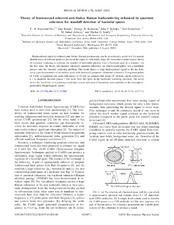| dc.creator | Ooi, C. H. Raymond | |
| dc.creator | Beadie, G. | |
| dc.creator | Kattawar, George W. | |
| dc.creator | Reintjes, J. F. | |
| dc.creator | Rostovtsev, Y. | |
| dc.creator | Zubairy, M. Suhail | |
| dc.creator | Scully, Marlan O. | |
| dc.date.accessioned | 2011-09-08T21:36:15Z | |
| dc.date.available | 2011-09-08T21:36:15Z | |
| dc.date.issued | 2005 | |
| dc.identifier.citation | C. H. Raymond Ooi, G. Beadie, George W. Kattawar, J. F. Reintjes, Y. Rostovtsev, M. Suhail Zubairy and Marlan O. Scully. Phys.Rev.A 72 023807 2005. "Copyright (2005) by the American Physical Society." | en |
| dc.identifier.uri | http://dx.doi.org/10.1103/PhysRevA.72.023807 | |
| dc.identifier.uri | https://hdl.handle.net/1969.1/126585 | |
| dc.description | Journals published by the American Physical Society can be found at http://publish.aps.org/ | en |
| dc.description.abstract | Backscattered signal of coherent anti-Stokes Raman spectroscopy can be an extremely useful tool for remote identification of airborne particles, provided the signal is sufficiently large. We formulate a semiclassical theory of nonlinear scattering to estimate the number of detectable photons from a bacterial spore at a distance. For the first time, the theory incorporates enhanced quantum coherence via femtosecond pulses and a nonlinear process into the classical scattering problem. Our result shows a large backscattered signal in the far field, using typical parameters of an anthrax spore with maximally prepared vibrational coherence. Using train pulses of 1 kHz of repetition rate each with energy of 10 mJ, we estimate that about 10(7) photons can be detected by a 1 m diameter detector placed 1 km away from the spore in the backward scattering direction. The result shows the feasibility of developing a real time remote detection of hazardous microparticles in the atmosphere, particularly biopathogenic spores. | en |
| dc.language.iso | en | |
| dc.publisher | American Physical Society | |
| dc.subject | NONLINEAR FREQUENCY-CONVERSION | en |
| dc.subject | DIPICOLINIC ACID | en |
| dc.subject | LIGHT-PULSES | en |
| dc.subject | LASER-PULSES | en |
| dc.subject | FAST CARS | en |
| dc.subject | GENERATION | en |
| dc.subject | SCATTERING | en |
| dc.subject | SPECTROSCOPY | en |
| dc.subject | PROPAGATION | en |
| dc.subject | DYNAMICS | en |
| dc.subject | Optics | en |
| dc.subject | Physics | en |
| dc.title | Theory of femtosecond coherent anti-Stokes Raman backscattering enhanced by quantum coherence for standoff detection of bacterial spores | en |
| dc.type | Article | en |
| local.department | Physics and Astronomy | en |


